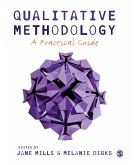All qualitative researchers sample, yet methods of sampling and choosing cases have received relatively little attention compared to other qualitative methods.
This innovative book critically evaluates widely used sampling strategies, identifying key theoretical assumptions and considering how empirical and theoretical claims are made from these diverse methods.
Nick Emmel presents a groundbreaking reworking of sampling and choosing cases in qualitative research. Drawing on international case studies from across the social sciences he shows how ideas drive choices, how cases are used to work out the relation between ideas and evidence, and why it is not the size of a sample that matters, it is how cases are used to interpret and explain that counts.
Fresh, dynamic and timely, this book is essential reading for researchers and postgraduate students engaging with sampling and realism in qualitative research.
This innovative book critically evaluates widely used sampling strategies, identifying key theoretical assumptions and considering how empirical and theoretical claims are made from these diverse methods.
Nick Emmel presents a groundbreaking reworking of sampling and choosing cases in qualitative research. Drawing on international case studies from across the social sciences he shows how ideas drive choices, how cases are used to work out the relation between ideas and evidence, and why it is not the size of a sample that matters, it is how cases are used to interpret and explain that counts.
Fresh, dynamic and timely, this book is essential reading for researchers and postgraduate students engaging with sampling and realism in qualitative research.
This text provides a clear guide to realist qualitative methods and also offers plenty of practical examples to illustrate its central argument that qualitative research would benefit greatly from a realist approach. It will prove helpful to researchers as well as those interested in teaching qualitative methods.
Bob Carter 20130901
Bob Carter 20130901








